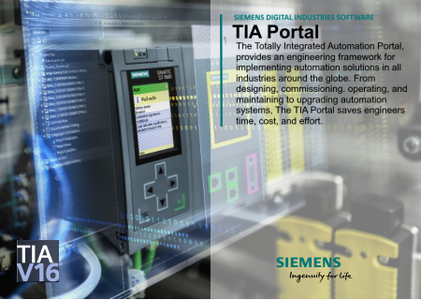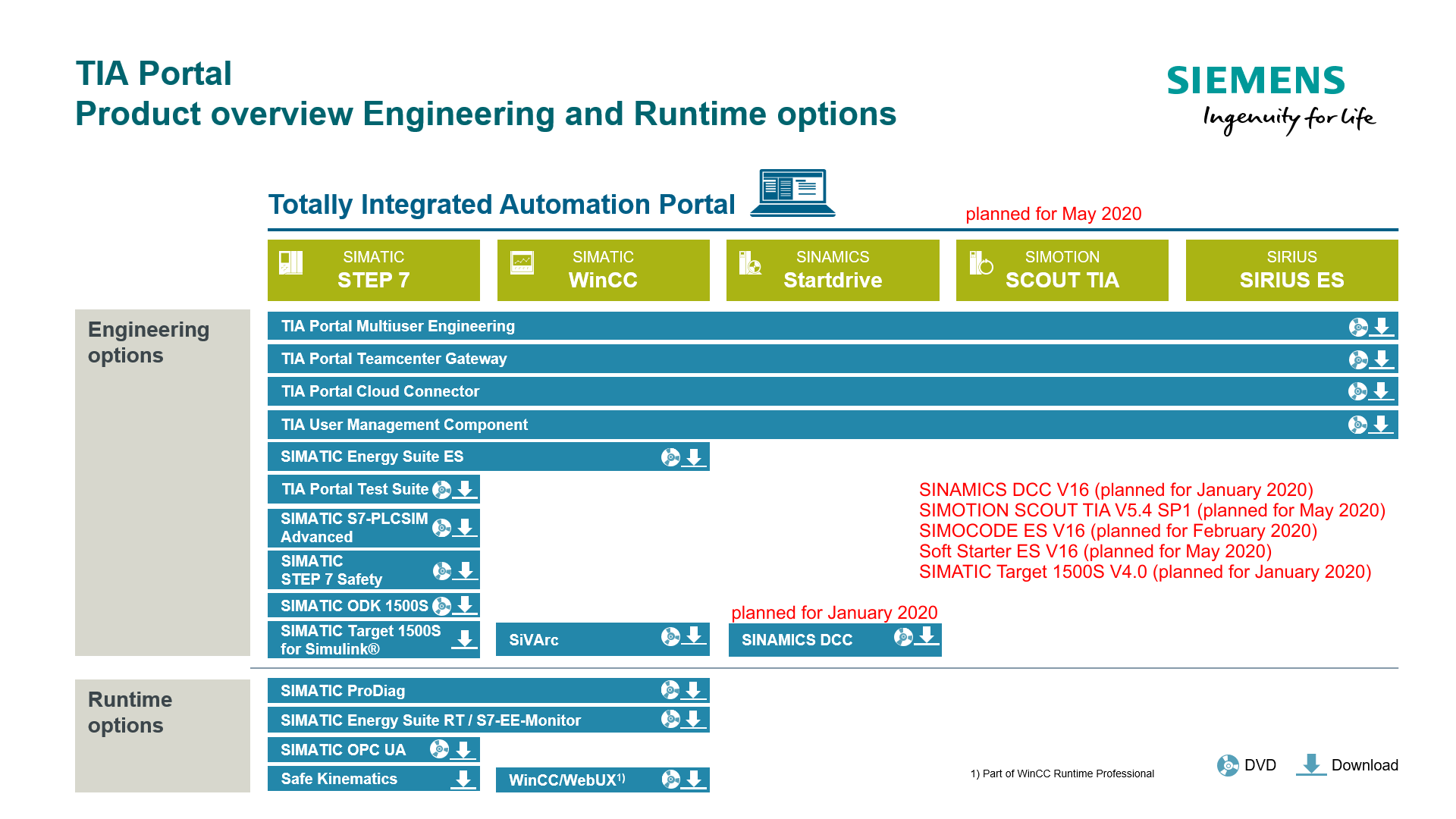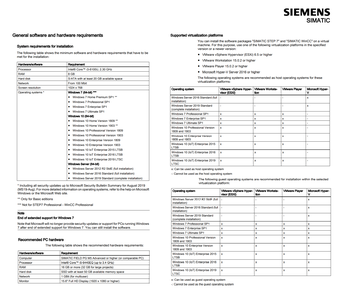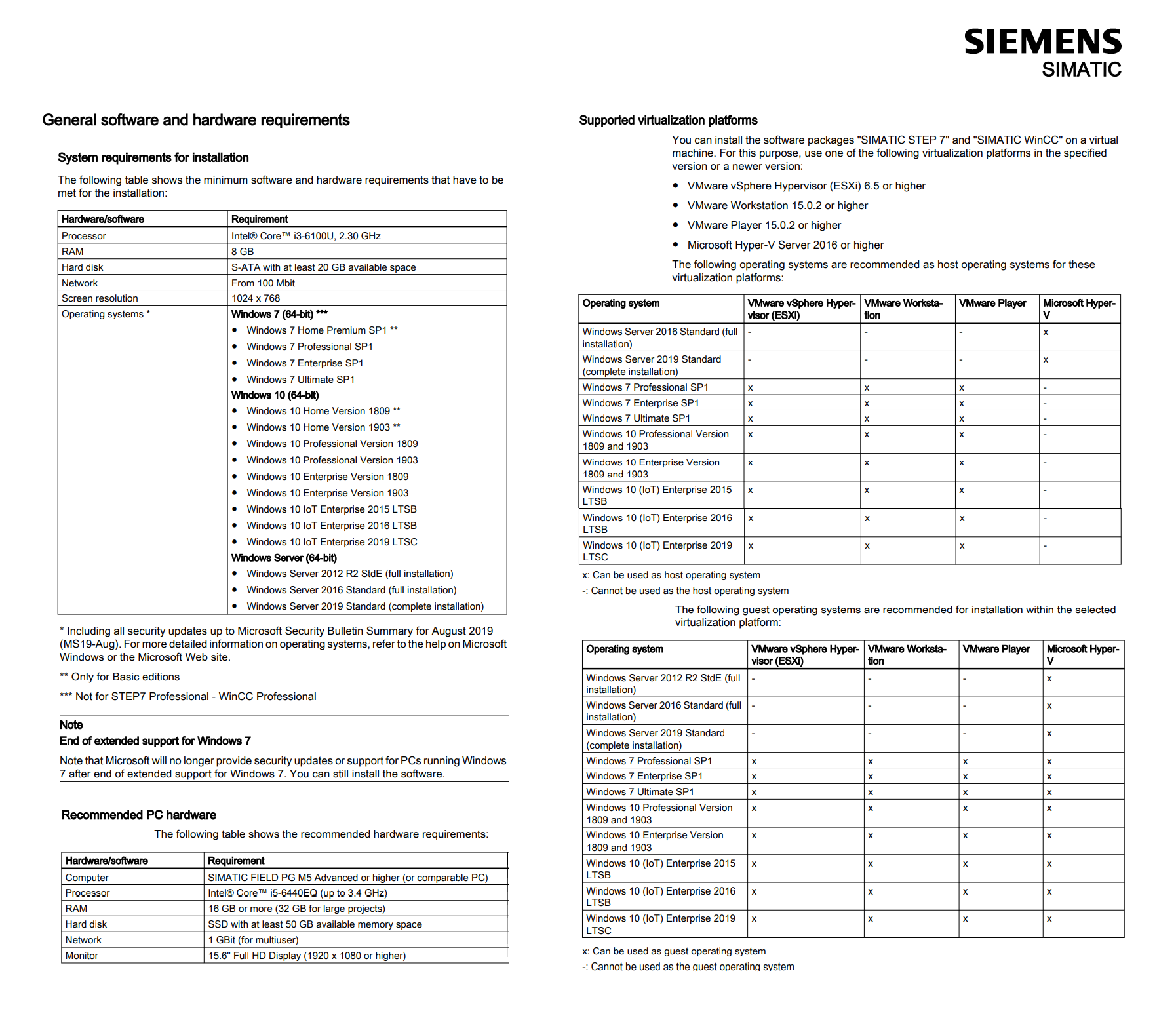Siemens Simatic TIA Portal 16.0 Update 6 | 123.5 Gb
Languages Supported: Deutsch, English, Italiano, Français, Español, 中文
Languages Supported: Deutsch, English, Italiano, Français, Español, 中文
Siemens Digital Industries (DI), the innovation leader in automation and digitalization, is pleased to announce the availability of TIA Portal V16 Update 6. This solution enables fully integrated engineering workflows based on the model of Continuous Integration, in which developers work as a coordinated team on automation projects.
Siemens Simatic TIA Portal V16 release notes - 26 November 2019
With the new TIA Portal V16 (Totally Integrated Automation Portal), Siemens has expanded its engineering framework with practical new functions for various phases from planning, to engineering, to commissioning. The innovations concentrate on the continuous integration of the development process. These include standardization, integrated engineering spread across teams and an integrated function test. This enables users to increase the quality of their software, shorten commissioning times and reduce engineering costs.
During the development process, the focus is on distributed working concepts and teamwork. On the TIA Portal project server, the user can now exclusively access server projects via the new Exclusive Engineering function – with features such as project revision and change protocol, as well as automated reporting and archiving. This means there are no functional restrictions when organizing automation tasks on a device, object or function-oriented basis. No special license is required for using Exclusive Engineering. To enable projects to be commissioned by teams, TIA Portal V16 has been expanded with an “asynchronous commissioning” mode, whereby loading to the Simatic S7-1500 controller is carried out by a second TIA Portal instance running in the background. The TIA Portal instance running in the foreground can be operated again immediately, enabling load times to be considerably shortened. TIA Portal V16 includes the new Version Control Interface (VCI) to external versioning systems such as GIT, SVN and TFS. The import and export of software objects via the TIA Portal interface allows versioning to be seamlessly integrated into the development process. This enables object-granular, completely transparent versioning of all software objects outside the TIA Portal. Another innovation is the TIA Portal Test Suite. In addition to allowing automated creation and checking of adherence to programming guidelines, the so-called Styleguide Check, it is also possible to generate and carry out application tests with the virtual S7-PLCSIM Advanced controller. This support reduces engineering and commissioning times and enhances the quality of the software.
With TIA Portal V16, all Simatic S7-1200 controllers are now equipped with OPC UA server functionality. Connection to higher-level systems, such as manufacturing execution systems, can be implemented for vertical data integration. Controller-controller communication throughout all Simatic controllers is also now possible using OPC UA. Standardized interfaces, known as companion specifications, are simple to import with the TIA Portal, making it easy to integrate machines in production lines or plants. The SiOME Siemens OPC UA Modelling Editor helps the automation engineer with the interconnection of tags and simplifies their import into the Simatic machine control. The SiOME also has some new functions such as the creation of data blocks based on OPC UA information models, or the option of checking OPC-UA information models and companion specifications for conformity. Users can now model server interfaces or companion specifications in the TIA Portal V16. In simplified form and without the need for specialist knowledge, it is possible to create a server interface or use a companion specification. The OPC UA server functionality for the Simatic S7-1500 controllers has also been supplemented with additional diagnostic buffer entries: OPC UA messages can now be combined to only appear once in the diagnostic buffer.
The new Simatic Drive Controller has been integrated for motion control applications. It combines a Simatic S7-1500 control system with motion control, technology and safety functionality with a Sinamics S120 drive control in a single device, thus saving space. The new package also enables Simatic users to perform advanced motion control tasks, such as those involving multi-axis drive systems, in a familiar environment. Simatic WinCC Unified is also available in TIA Portal V16: The completely redesigned visualization system provides solutions for HMI and SCADA applications, and in the future also for Industrial Edge, Cloud and Augmented Reality scenarios. It includes a new generation of HMI devices which can be configured with TIA Portal V16, namely the Simatic HMI Unified Comfort Panels. In the latest TIA Portal version, the Simatic Energy Suite includes a load management function. This option automatically prevents load peaks by using intelligent strategies to switch generators and loads on and off, without influencing the production process. The Simatic Energy Suite engineering takes place in the TIA Portal: The user configures the load management via the screen form in the TIA Portal, program generation is completed, and the corresponding visualization configured.
During the development process, the focus is on distributed working concepts and teamwork. On the TIA Portal project server, the user can now exclusively access server projects via the new Exclusive Engineering function – with features such as project revision and change protocol, as well as automated reporting and archiving. This means there are no functional restrictions when organizing automation tasks on a device, object or function-oriented basis. No special license is required for using Exclusive Engineering. To enable projects to be commissioned by teams, TIA Portal V16 has been expanded with an “asynchronous commissioning” mode, whereby loading to the Simatic S7-1500 controller is carried out by a second TIA Portal instance running in the background. The TIA Portal instance running in the foreground can be operated again immediately, enabling load times to be considerably shortened. TIA Portal V16 includes the new Version Control Interface (VCI) to external versioning systems such as GIT, SVN and TFS. The import and export of software objects via the TIA Portal interface allows versioning to be seamlessly integrated into the development process. This enables object-granular, completely transparent versioning of all software objects outside the TIA Portal. Another innovation is the TIA Portal Test Suite. In addition to allowing automated creation and checking of adherence to programming guidelines, the so-called Styleguide Check, it is also possible to generate and carry out application tests with the virtual S7-PLCSIM Advanced controller. This support reduces engineering and commissioning times and enhances the quality of the software.
With TIA Portal V16, all Simatic S7-1200 controllers are now equipped with OPC UA server functionality. Connection to higher-level systems, such as manufacturing execution systems, can be implemented for vertical data integration. Controller-controller communication throughout all Simatic controllers is also now possible using OPC UA. Standardized interfaces, known as companion specifications, are simple to import with the TIA Portal, making it easy to integrate machines in production lines or plants. The SiOME Siemens OPC UA Modelling Editor helps the automation engineer with the interconnection of tags and simplifies their import into the Simatic machine control. The SiOME also has some new functions such as the creation of data blocks based on OPC UA information models, or the option of checking OPC-UA information models and companion specifications for conformity. Users can now model server interfaces or companion specifications in the TIA Portal V16. In simplified form and without the need for specialist knowledge, it is possible to create a server interface or use a companion specification. The OPC UA server functionality for the Simatic S7-1500 controllers has also been supplemented with additional diagnostic buffer entries: OPC UA messages can now be combined to only appear once in the diagnostic buffer.
The new Simatic Drive Controller has been integrated for motion control applications. It combines a Simatic S7-1500 control system with motion control, technology and safety functionality with a Sinamics S120 drive control in a single device, thus saving space. The new package also enables Simatic users to perform advanced motion control tasks, such as those involving multi-axis drive systems, in a familiar environment. Simatic WinCC Unified is also available in TIA Portal V16: The completely redesigned visualization system provides solutions for HMI and SCADA applications, and in the future also for Industrial Edge, Cloud and Augmented Reality scenarios. It includes a new generation of HMI devices which can be configured with TIA Portal V16, namely the Simatic HMI Unified Comfort Panels. In the latest TIA Portal version, the Simatic Energy Suite includes a load management function. This option automatically prevents load peaks by using intelligent strategies to switch generators and loads on and off, without influencing the production process. The Simatic Energy Suite engineering takes place in the TIA Portal: The user configures the load management via the screen form in the TIA Portal, program generation is completed, and the corresponding visualization configured.
TIA Portal: V16 - What's new?
This Update is valid for the following products on TIA Portal:
- STEP 7 Basic/Professional V16
- S7-PLCSIM V16
- WinCC Basic/Comfort/Advanced/Professional/Unified V16
Improvements in STEP 7
This update contains the following improvements and changes:
Working with the TIA Portal
- Stability when working with the TIA Portal has been improved, partly based on the feedback from returned crash reports.
Animated maximizing or minimizing of windows on high-resolution monitors
- Animated maximizing or minimizing of windows in the project view results in display problems on high-resolution monitors. This behavior occurs with animated maximizing or minimizing of the task cards, the project tree and the Inspector window.
- To bypass the display problems, disable animated maximizing and minimizing. To do so, select the "Settings" command in the "Options" menu. Open the "General" entry in the area navigation of the settings. In the "General Settings" group, uncheck the check box "Window animation: Animate window during maximizing and minimizing".
Monitoring a program (S7-1200/1500)
- Monitoring a program can significantly increase the cycle time of the CPU, depending in each case on the number of variables to be monitored and the number of loops used.
- When monitoring is switched on, a dialog box warns of the possible increase in the cycle time. In this dialog box, you can continue or abort the monitoring.
- To prevent this dialog box from being displayed again, while the project is open, check the check box "Do not show again" and end the dialog with "Yes".
- If the dialog is ended with "No", the check box has no effect.
Inverted RLO at EN enable input (FBD, S7-1200/S7-1500)
Inversion at the EN enable input is not evaluated correctly under the following conditions:
- A multiple instruction is directly interconnected to the inverted EN input of an instruction in an FBD network.
- The instruction has additional Boolean inputs.
- At least one of the Boolean inputs is not directly supplied with an operand.
Interconnect a simple instruction box to an inverted EN input instead of the multiple instruction.
Improvements in WinCC
This update contains the following improvements and changes:
Stability and performance
The stability and performance have been improved, among others, on account of the feedback received.
Runtime Advanced
This update contains the following improvements and changes:
Stability and performance
The stability and performance have been improved, among others, on account of the feedback received.
Runtime Professional
This update contains the following improvements and changes:
Stability and performance
The stability and performance have been improved, among others, on account of the feedback received.
Reading PLC tags
Reading PLC tags via VB script has been improved.
Improvements in WinCC Unified
This update contains the following improvements and changes:
Stability and performance
The stability and performance have been improved, among others, on account of the feedback received.
Unified PC
This update contains the following improvements and changes:
Stability and performance
Improvements including stability and performance have been made based on the feedback received.
Unified Panel
Improvements in V16 Upd. 6 (Unified Comfort Panels)
This update contains the HMI device image version 16.0.0.6 for projects that were configured with WinCC Unified V16 Update 4.
Transfer channel
With this update, the transfer on the Unified Comfort Panel is automatically adjusted; the parameter "Service and Commissioning" > "Transfer" > "Transfer channel" in the Control Panel is being dispensed with
- STEP 7 Basic/Professional V16
- S7-PLCSIM V16
- WinCC Basic/Comfort/Advanced/Professional/Unified V16
Improvements in STEP 7
This update contains the following improvements and changes:
Working with the TIA Portal
- Stability when working with the TIA Portal has been improved, partly based on the feedback from returned crash reports.
Animated maximizing or minimizing of windows on high-resolution monitors
- Animated maximizing or minimizing of windows in the project view results in display problems on high-resolution monitors. This behavior occurs with animated maximizing or minimizing of the task cards, the project tree and the Inspector window.
- To bypass the display problems, disable animated maximizing and minimizing. To do so, select the "Settings" command in the "Options" menu. Open the "General" entry in the area navigation of the settings. In the "General Settings" group, uncheck the check box "Window animation: Animate window during maximizing and minimizing".
Monitoring a program (S7-1200/1500)
- Monitoring a program can significantly increase the cycle time of the CPU, depending in each case on the number of variables to be monitored and the number of loops used.
- When monitoring is switched on, a dialog box warns of the possible increase in the cycle time. In this dialog box, you can continue or abort the monitoring.
- To prevent this dialog box from being displayed again, while the project is open, check the check box "Do not show again" and end the dialog with "Yes".
- If the dialog is ended with "No", the check box has no effect.
Inverted RLO at EN enable input (FBD, S7-1200/S7-1500)
Inversion at the EN enable input is not evaluated correctly under the following conditions:
- A multiple instruction is directly interconnected to the inverted EN input of an instruction in an FBD network.
- The instruction has additional Boolean inputs.
- At least one of the Boolean inputs is not directly supplied with an operand.
Interconnect a simple instruction box to an inverted EN input instead of the multiple instruction.
Improvements in WinCC
This update contains the following improvements and changes:
Stability and performance
The stability and performance have been improved, among others, on account of the feedback received.
Runtime Advanced
This update contains the following improvements and changes:
Stability and performance
The stability and performance have been improved, among others, on account of the feedback received.
Runtime Professional
This update contains the following improvements and changes:
Stability and performance
The stability and performance have been improved, among others, on account of the feedback received.
Reading PLC tags
Reading PLC tags via VB script has been improved.
Improvements in WinCC Unified
This update contains the following improvements and changes:
Stability and performance
The stability and performance have been improved, among others, on account of the feedback received.
Unified PC
This update contains the following improvements and changes:
Stability and performance
Improvements including stability and performance have been made based on the feedback received.
Unified Panel
Improvements in V16 Upd. 6 (Unified Comfort Panels)
This update contains the HMI device image version 16.0.0.6 for projects that were configured with WinCC Unified V16 Update 4.
Transfer channel
With this update, the transfer on the Unified Comfort Panel is automatically adjusted; the parameter "Service and Commissioning" > "Transfer" > "Transfer channel" in the Control Panel is being dispensed with
The TIA Portal (Totally Integrated Automation Portal) was launched by Siemens in 2010 and enables users to perform automation and drive tasks quickly and intuitively through efficient configuration. The software architecture is designed for high efficiency and ease of use and is suitable for both new and experienced users. It offers a standardized operating concept for controllers, human machine interfaces (HMIs) and drives for shared data storage and consistency, for example during configuration, communication and diagnostics, as well as powerful and comprehensive automation object libraries. The simple engineering in the TIA Portal facilitates full access to the entire spectrum of digitized automation, from digital planning and integrated engineering up to transparent operation. Alongside PLM (Product Lifecycle Management) and MES (Manufacturing Execution Systems) within the Digital Enterprise Software Suite, the TIA Portal complements the holistic range of software available from Siemens for companies on the path toward Industry 4.0.
As from the TIA Portal V16, there was the introduction of the WinCC Unified. This is an engineering platform for HMI Comfort Unified and for WinCC Unified PC. It brings many news regarding the WinCC Advanced / WinCC Professional. Among other things, this version is heavily supported by HTML5, (including for simulation purposes, which differs from previous versions).
Tia Portal V16: First project and simulation of WinCC Unified.
Siemens Digital Industries (DI) is an innovation leader in automation and digitalization. Closely collaborating with partners and customers, DI drives the digital transformation in the process and discrete industries. With its Digital Enterprise portfolio, DI provides companies of all sizes with an end-to-end set of products, solutions and services to integrate and digitalize the entire value chain.
Siemens Digital Industries has its global headquarters in Nuremberg, Germany, and has around 76,000 employees internationally.
Product: Siemens Simatic TIA Portal
Version: V16 Update 6
Supported Architectures: x64
Website Home Page : https://support.industry.siemens.com/
Languages Supported: multilanguage
System Requirements: Windows *
Size: 123.5 Gb
Please visit my blog
Added by 3% of the overall size of the archive of information for the restoration
No mirrors please
Added by 3% of the overall size of the archive of information for the restoration
No mirrors please









